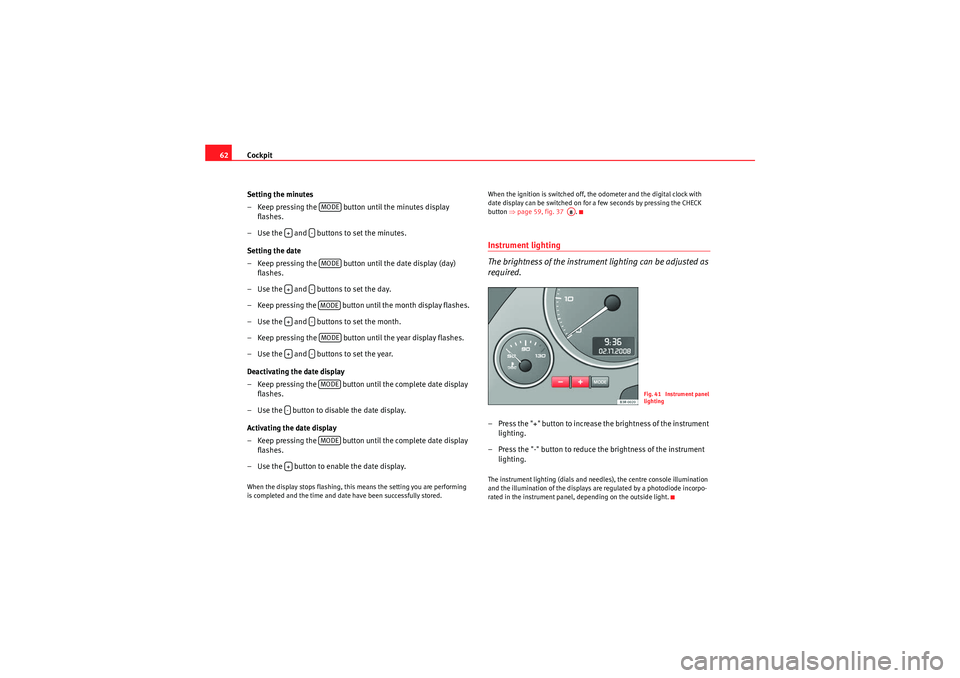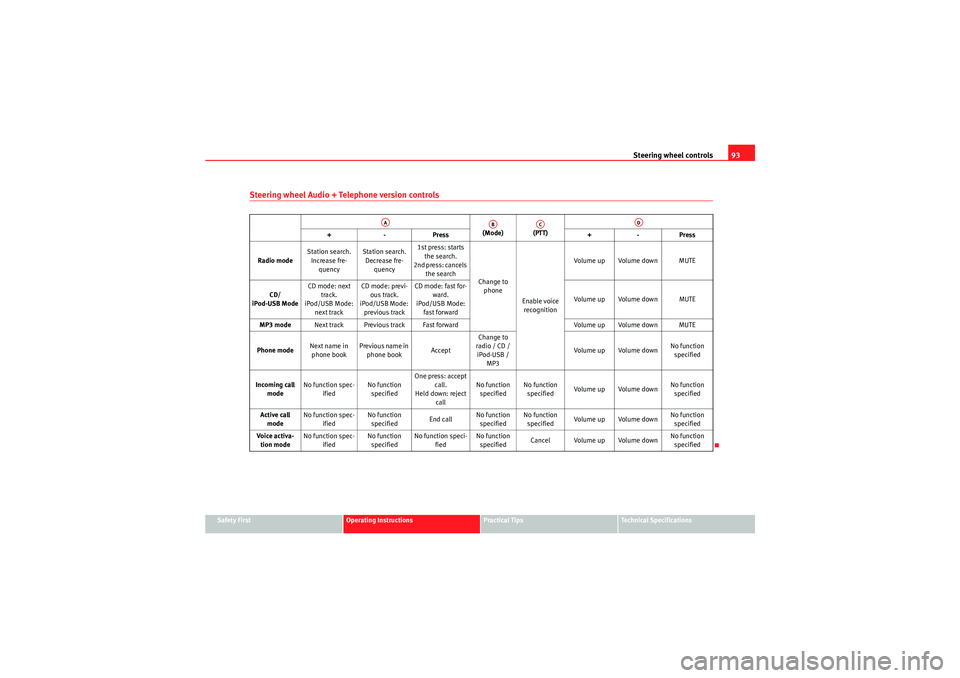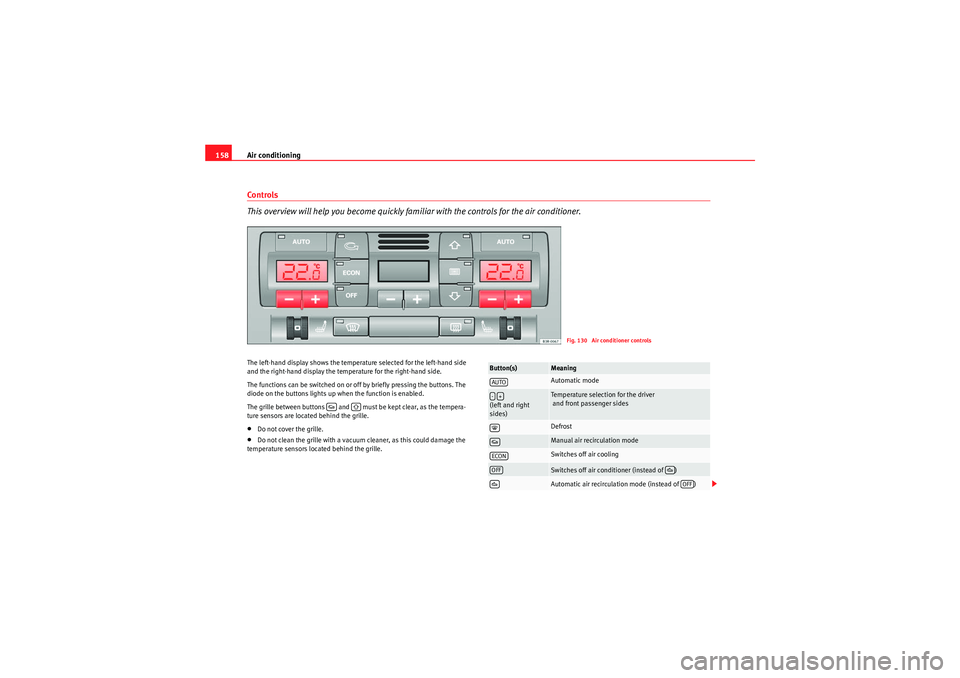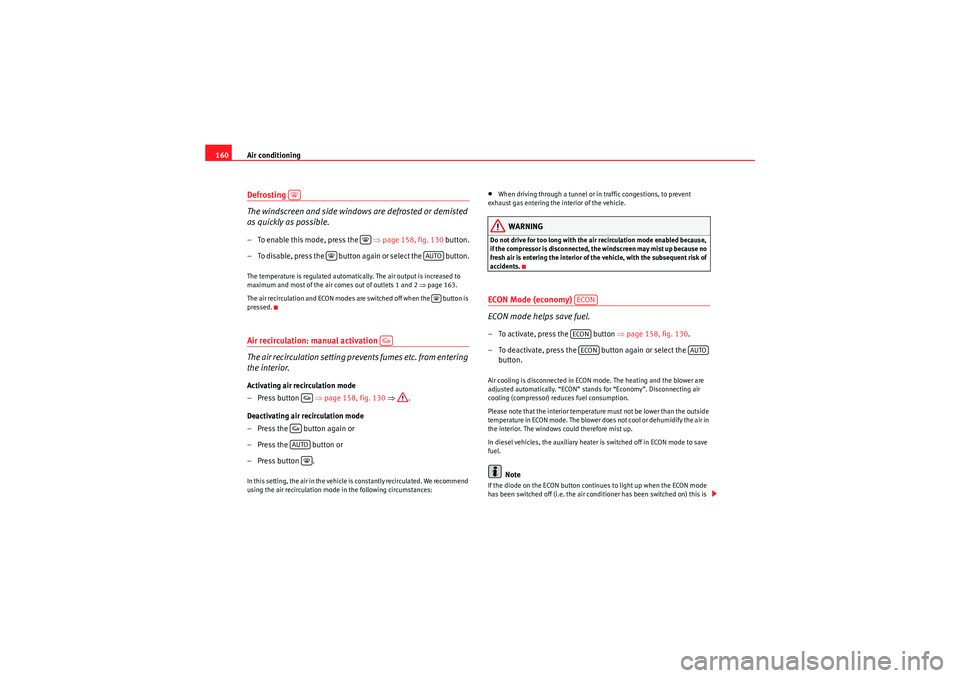ECO mode Seat Exeo 2010 Owner's manual
[x] Cancel search | Manufacturer: SEAT, Model Year: 2010, Model line: Exeo, Model: Seat Exeo 2010Pages: 319, PDF Size: 9.64 MB
Page 64 of 319

Cockpit
62
Setting the minutes
– Keep pressing the button until the minutes display flashes.
– Use the and buttons to set the minutes.
Setting the date
– Keep pressing the button until the date display (day) flashes.
– Use the and buttons to set the day.
– Keep pressing the button until the month display flashes.
– Use the and buttons to set the month.
– Keep pressing the button until the year display flashes.
– Use the and buttons to set the year.
Deactivating the date display
– Keep pressing the button until the complete date display flashes.
– Use the button to disable the date display.
Activating the date display
– Keep pressing the button until the complete date display flashes.
– Use the button to enable the date display.When the display stops flashing, this means the setting you are performing
is completed and the time and date have been successfully stored. When the ignition is switched off, the odometer and the digital clock with
date display can be switched on for a few seconds by pressing the CHECK
button
⇒page 59, fig. 37 .
Instrument lighting
The brightness of the instrument lighting can be adjusted as
required.– Press the "+" button to increase the brightness of the instrument
lighting.
– Press the "-" button to reduce the brightness of the instrument lighting.The instrument lighting (dials and needles), the centre console illumination
and the illumination of the displays are regulated by a photodiode incorpo-
rated in the instrument panel, depending on the outside light.
MODE
+
-MODE
+
-MODE
+
-MODE
+
-MODE
-
MODE
+
A8
Fig. 41 Instrument panel
lighting
exeo_EN.book Seite 62 Montag, 30. August 2010 4:45 16
Page 65 of 319

Cockpit63
Safety First
Operating Instructions
Practical Tips
Technical Specifications
Speedometer with odometer
The speedometer indicates the speed of the vehicle and the
distance travelled.The distance is normally stated in kilometres (km). On some models,
however, the odometer will show “miles”.
Lower odometer
The lower odometer records the vehicle’s total mileage.
Upper odometer (trip recorder)
The upper odometer shows the distance that has been travelled since the trip
recorder was last reset. It is used to measure short trips. The last digit of the
trip recorder indicates distances of 100 metres or tenths of a mile. The upper
odometer can be reset to zero by pressing the reset button ⇒fig. 42 . Fault display
If there is a fault in the instrument panel, the letters
DEF will appear perma-
nently in the trip recorder display. Please have the fault repaired as soon as
possible.
Electronic immobiliser
The vehicle key data is consulted when the ignition is switched on.
If an uncoded key is used, the message SAFE will appear in the trip recorder
display. The vehicle can no longer be started if that happens.
Fuel reserveThe display only works when the ignition is switched on.
When the needle reaches the reserve zone, the symbol
lights up in the
instrument panel display ⇒ page 80. At this point there are still about 8 to 10
litres of fuel left in the tank. This is your reminder to fill up soon.
You can consult the tank capacity of your vehicle in the ⇒page 305, “Dimen-
sions and capacities” section.
Caution
N e v e r r un t h e ta n k co m p le t e l y d r y. I f t h e r e i s a n i r r e g u la r f u e l s u p p l y, m i s f i r i ng
can occur. This means that fuel could reach the exhaust system without
burning. This may lead to the catalytic converter reheating and being
damaged.
Fig. 42 Detailed view of
the instrument panel:
Odometer
exeo_EN.book Seite 63 Montag, 30. August 2010 4:45 16
Page 77 of 319

Cockpit75
Safety First
Operating Instructions
Practical Tips
Technical Specifications
Service reminder
The instrument panel controls the distance travelled every day. It calculates
the average of these distances travelled and activates the service reminder
sufficiently in advance.
The display reverts back to the standard display after about 5 seconds. The
remaining distance to the next service is updated every time the ignition is
switched on, until the service becomes due.
Service due
When a service is due,
SERVICE! will appear in the display immediately after
you switch on the ignition. The display reverts back to the standard display
after about 5 seconds.
Resetting the display
The display is reset by the workshop after the service has been carried out.
The service interval will be set to a LongLife Service (flexible service interval)
or Inspection Service (fixed service interval), depending on which engine oil
is used. It is only possible to reset the display via the instrument panel when
a n o i l cha n ge i s p e r f o r m e d ; i n t h is cas e t h e d is p l a y ca n o n l y b e r e s e t t o a f i xe d
service interval of 15,000 km. Proceed as follows:
•Switch the ignition off.•Press the service button ⇒page 74, fig. 52 and hold while switching
on the ignition. The display will show one of these messages: Service in -----
km or Service!•Now press and hold the reset button until the display shows Service
in ----- km --- days or Service!
The display switches out of the reset mode if you do not press the reset button
within 5 seconds.Caution
The system cannot calculate the figures for the service interval display if the
battery is disconnected from the vehicle, so no service reminder can be displayed during this time. Please remember that it is essential to service the
vehicle within the established time limits to prevent its deterioration and to
extend its useful life (particularly that of the engine). The period between two
services must never be longer than the time specified in the Maintenance
Programme, even if you only cover a low mileage during this time.
Note
•Do not reset the service indicator between services, otherwise the display
will be incorrect.•The information in the service indicator remains intact if the battery is
disconnected.•The distance to the next service cannot be called up if the system has
detected a Priority 1 fault (red symbol).Auto-check systemIntroductionThe auto-check system checks important components and vehicle systems.
These background checks are run constantly, as long as the ignition is
switched on.
A message is displayed on the instrument panel if a fault should occur or if
any maintenance or repairs are urgently required. This is accompanied by an
audible warning signal. Depending on the priority of the fault, a red or yellow
warning symbol lights up on the display.
The red symbol indicates danger, whereas the yellow one represents a
warning . Additional messages for the driver may be shown with the red or
yellow symbols.
A1
A2
exeo_EN.book Seite 75 Montag, 30. August 2010 4:45 16
Page 95 of 319

Steering wheel controls93
Safety First
Operating Instructions
Practical Tips
Technical Specifications
Steering wheel Audio + Telephone version controls
(Mode) (PTT)
+-P re ss +-Pre ss
Radio mode Station search.
Increase fre- quency Station search.
Decrease fre- quency 1st press: starts
the search.
2nd press: cancels the search Change to
phone
Enable voice recognition Volume up Volume down MUTE
CD/
iPod-USB Mode CD mode: next
track.
iPod/USB Mode: next track CD mode: previ-
ous track.
iPod/USB Mode: previous track CD mode: fast for-
ward.
iPod/USB Mode: fast forward Volume up Volume down MUTE
MP3 mode Next track Previous track Fast forward Volume up Volume down MUTE
Phone mode Next name in
phone book Previous name in
phone book AcceptChange to
radio / CD / iPod-USB / MP3 Volume up Volume down
No function
specified
Incoming call mode No function spec-
ified No function
specified One press: accept
call.
Held down: reject call No function
specified No function
specified Volume up Volume down No function
specified
Active call mode No function spec-
ified No function
specified End callNo function
specified No function
specified Volume up Volume down No function
specified
Voice activa- tion mode No function spec-
ified No function
specified No function speci-
fied No function
specified Cancel Volume up Volume down No function
specified
AA
AB
AC
AD
exeo_EN.book Seite 93 Montag, 30. August 2010 4:45 16
Page 97 of 319

Steering wheel controls95
Safety First
Operating Instructions
Practical Tips
Technical Specifications
Steering wheel controls, Navigation System + Telephone* version
(Mode) (PTT)
+-P re ss +-Pre ss
Radio mode Station search.
Increase fre- quency Station search.
Decrease fre- quency 1st press: starts
the search.
2nd press: cancels the search
Change to phone
Enable voice recognition Volume up Volume down
Repetition of
the last naviga- tion order (only if active)
CD/
iPod-USB Mode CD mode: next
track.
iPod/USB Mode: next track CD mode: previ-
ous track.
iPod/USB Mode: previous track CD mode: fast for-
ward.
iPod/USB Mode: fast forward Volume up Volume downRepetition of
the last naviga- tion order (only if active)
MP3 mode Next track Previous track Fast forward Volume up Volume downRepetition of
the last naviga- tion order (only if active)
Phone mode Next name in
phone book Previous name in
phone book AcceptChange to
radio / CD / iPod-USB / MP3 Volume up Volume down Repetition of
the last naviga- tion order (only if active)
Incoming call mode No function spec-
ified No function
specified One press: accept
call.
Held down: reject call No function
specified No function
specified Volume up Volume down Repetition of
the last naviga- tion order (only if active)
Active call mode No function spec-
ified No function
specified End callNo function
specified No function
specified Volume up Volume down Repetition of
the last naviga- tion order (only if active)
Voice activa- tion mode No function spec-
ified No function
specified No function speci-
fied No function
specified Cancel Volume up Volume down No function
specified
AA
AB
AC
AD
exeo_EN.book Seite 95 Montag, 30. August 2010 4:45 16
Page 158 of 319

Air conditioning
156Air conditioning2C-ClimatronicDescription
The air conditioner is designed to automatically keep the
passenger compartment at the temperature you find most
comfortable at all times of the year.Recommended settings:
– Set the temperature to 22°C (71°F).
–Press the button ⇒page 158, fig. 130 .The following setting quickly provides a comfortable temperature inside the
vehicle. We therefore recommend you do not modify the setting unless you
find this temperature uncomfortable or where circumstances require as such.
The air conditioner provides heating and ventilation and also cools and dehu-
midifies the air inside the vehicle.
The air conditioner is fully automatic and will constantly maintain the temper-
ature which has been set. To achieve this, the temperature of the air supplied
to the interior, the blower speed (volume of air delivery) and the air distribu-
tion are regulated automatically. The system also takes solar radiation into
account and, therefore, no subsequent manual readjustments are required.
Therefore, automatic mode ⇒ page 159 should be used for the comfort of all
the passengers in virtually all conditions throughout the year.
Please note the following points:
The humidity of the air is automatically reduced when the system cools the
interior of the vehicle. This helps to prevent condensation on the windows. If the humidity and temperature outside the vehicle are high,
condensation
can drip off the evaporator in the air cooling system and form a pool under-
neath the vehicle. This is normal and does not indicate a leak.
If the outside temperature is low, the blower normally only switches to a
higher speed once the coolant has warmed up sufficiently (this does not
apply to the defrost setting).
In order to achieve maximum engine power, the air conditioner compressor is
temporarily switched off when pulling away from standstill with full throttle.
The compressor also switches off if the coolant temperature is excessively
high to ensure adequate engine cooling under extreme loads.
Pollution filter
The pollution filter (a combined particulate filter and activated charcoal filter)
serves as a barrier against impurities in the outside air, including dust and
pollen.
For the air conditioner to work with maximum efficiency, the pollution filter
element must be replaced at the intervals specified in the Service Plan.
If the vehicle is driven in areas with a high level of air pollution and the filter
is no longer fully effective, it may be necessary to change the filter element
more frequently.
Caution
•If you suspect that the air conditioner system is damaged, switch over to
ECON mode to prevent further damage and have the system checked by a
qualified workshop.•Repairs to the air conditioner require specialist knowledge and special
tools. For this reason, please contact a qualified workshop if the system is not
working properly.
AUTO
exeo_EN.book Seite 156 Montag, 30. August 2010 4:45 16
Page 160 of 319

Air conditioning
158Controls
This overview will help you become quickly fami liar with the controls for the air conditioner.The left-hand display shows the temperature selected for the left-hand side
and the right-hand display the temperature for the right-hand side.
The functions can be switched on or off by briefly pressing the buttons. The
diode on the buttons lights up when the function is enabled.
The grille between buttons and must be kept clear, as the tempera-
ture sensors are located behind the grille.•Do not cover the grille.•Do not clean the grille with a vacuum cleaner, as this could damage the
temperature sensors located behind the grille.
Fig. 130 Air conditioner controls
Button(s)
MeaningAutomatic mode
(left and right
sides)
Temperature selection for the driver
and front passenger sidesDefrostManual air recirculation modeSwitches off air coolingSwitches off air conditioner (instead of )Automatic air recirculation mode (instead of )
AUTO-+�<ECONOFF
OFF
exeo_EN.book Seite 158 Montag, 30. August 2010 4:45 16
Page 161 of 319

Air conditioning159
Safety First
Operating Instructions
Practical Tips
Technical Specifications
The , and buttons (which regulate air distribution) can either be
selected individually or in combination.
Automatic mode
Standard setting for all seasons.Switching on automatic mode
– Select a temperature between +18°C (64°F) and +29°C (86°F).
– Press the button
⇒page 158, fig. 130 .The automatic mode maintains a constant temperature inside the vehicle and
dehumidifies the air. Air temperature, air delivery and air distribution are
regulated automatically to reach the desired interior temperature as quickly
as possible, and then to maintain this temperature. The system automatically
compensates for any variations in the outside temperature and for the effect
of direct sunlight.
The automatic temperature regulation only operates at temperature settings
between +18°C and +29°C. If a temperature below +18°C is selected, LO
appears on the display. If a temperature is selected which is higher than
+29°C, the display will show HI. In the maximum and minimum settings, the
climate control operates continuously with maximum cooling or heating output and the temperature is not regulated automatically. The temperature
is not regulated.
Note
By keeping the button on the driver side pressed for several seconds,
the temperature of the passenger side can be set to the temperature of the
driver side or vice versa. The display indicates the new temperature value.Selecting the temperature
Separate temperatures can be selected for the driver and
front passenger sides.– Press the or buttons below the displays
⇒page 158,
fig. 130 until the desired temperature is selected for the driver
side or front passenger side.The currently selected temperature setting is shown in the display above the
buttons.
By keeping the button on the driver side pressed for several seconds,
the temperature of the passenger side can be set to the temperature of the
driver side or vice versa. The display indicates the new temperature value. The
previous temperature setting can be restored by resetting the display on the
driver or passenger side as required.
(centre buttons)
Adjusts blower speedAir to the windowsAir from the dashboard outletsAir to the footwells
Button(s)
Meaning
-+
AUTO
AUTO
AUTO
-+
-
+
AUTO
exeo_EN.book Seite 159 Montag, 30. August 2010 4:45 16
Page 162 of 319

Air conditioning
160Defrosting
The windscreen and side windows are defrosted or demisted
as quickly as possible.– To enable this mode, press the ⇒page 158, fig. 130 button.
– To disable, press the button again or select the button.The temperature is regulated automatically. The air output is increased to
maximum and most of the air comes out of outlets 1 and 2 ⇒page 163.
The air recirculation and ECON modes are switched off when the button is
pressed.Air recirculation: manual activation
The air recirculation setting prevents fumes etc. from entering
the interior.Activating air recirculation mode
–Press button ⇒page 158, fig. 130 ⇒ .
Deactivating air recirculation mode
– Press the button again or
– Press the button or
–Press button .In this setting, the air in the vehicle is constantly recirculated. We recommend
using the air recirculation mode in the following circumstances:
•When driving through a tunnel or in traffic congestions, to prevent
exhaust gas entering the interior of the vehicle.WARNING
Do not drive for too long with the air recirculation mode enabled because,
if the compressor is disconnected, the windscreen may mist up because no
fresh air is entering the interior of the vehicle, with the subsequent risk of
accidents.ECON Mode (economy)
ECON mode helps save fuel.– To activate, press the button ⇒page 158, fig. 130 .
– To deactivate, press the button again or select the button.Air cooling is disconnected in ECON mode. The heating and the blower are
adjusted automatically. “ECON” stands for “Economy”. Disconnecting air
cooling (compressor) reduces fuel consumption.
Please note that the interior temperature must not be lower than the outside
temperature in ECON mode. The blower does not cool or dehumidify the air in
the interior. The windows could therefore mist up.
In diesel vehicles, the auxiliary heater is switched off in ECON mode to save
fuel.
Note
If the diode on the ECON button continues to light up when the ECON mode
has been switched off (i.e. the air conditioner has been switched on) this is
�<
�<
�<
AUTO�<
AUTO�<
ECONECONECON
AUTO
exeo_EN.book Seite 160 Montag, 30. August 2010 4:45 16
Page 163 of 319

Air conditioning161
Safety First
Operating Instructions
Practical Tips
Technical Specifications
due to a defect in one of the air conditioner components. If a malfunction
should occur, please contact a specialised workshop.
Air recirculation: automatic activation*
If the outside air is polluted by diesel and petrol emissions,
an air quality sensor in the vehicle will automatically switch
on the air recirculation.Activating air recirculation mode
– Press the button
⇒fig. 131 .
Deactivating air recirculation mode
– Press the button again or
– Press the button or – Press button .
The automatic air recirculation mode should normally be left switched on at
all times.
The system is ready to operate approx. 30 seconds after the engine ignition
key has been turned. During this initial period, fresh air is fed into the vehicle.
If the
air purity sensor in the air conditioner detects a certain concentration
of fumes in the outside air, the control unit will either pass the incoming air
through the pollution filter or automatically switch on the air recirculation. If
there is a high concentration of pollution in the outside air, the air conditioner
automatically switches to air recirculation and the supply of air from the
outside is cut off. As soon as the level of pollution decreases, air is fed into
the vehicle from the outside again.
The automatic air recirculation operates for a maximum period of 12 minutes.
If the windows mist up when the automatic air recirculation is on, press the button immediately.
The automatic air recirculation switches itself off under certain circumstances
(for instance if or is selected). In “ECON” and at temperatures lower
than approx. 8°C below zero, the automatic air recirculation mode is limited
to 12 seconds.Switching the temperature displa y from °C to °F and vice versa
The temperature display can be switched from °C (degrees
Celsius) to °F (degrees Fahrenheit) and vice versa.– Press and hold the button for air recirculation mode and
briefly press the plus button of the left-hand temperature
selector ⇒page 158, fig. 130 .
Fig. 131 Button for auto-
matic air recirculation
AUTO
�<
�<
�<
exeo_EN.book Seite 161 Montag, 30. August 2010 4:45 16